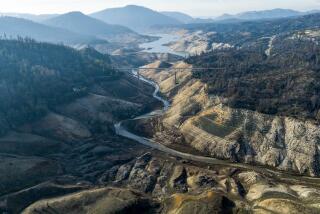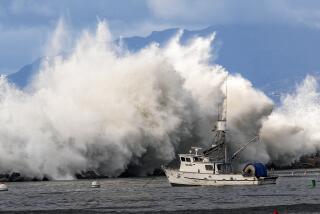What happened to El Niño? Be patient, L.A., it’ll come, expert says
- Share via
REPORTING FROM SAN FRANCISCO — When the first hints of El Niño developed last year, experts believed that the brunt of the rain would occur in Southern California rather than Northern California.
So far this season, the opposite has happened.
Since Oct. 1, San Francisco was at 100% of average rainfall as of Monday; Eureka at 142% and Fresno, 152%. Yet Los Angeles was only at 64% of average.
What gives?
See more of our top stories on Facebook >>
The answer is that much of the rain Northern California has received in recent months is not significantly related to El Niño. Most of that precipitation — including this week’s storms hitting San Francisco — is coming from the typical winter weather pattern in California: cold storms from the northern Pacific Ocean, coming northwest of the state.
Northern California — like the rest of the state — saw less rain during four years of drought. But this season is shaping up to be a wet year in the north, bringing more rain and snow than the region has seen in several years.
The only El Niño-driven storms that have hit California arrived in the first week of January and then ended, said NASA Jet Propulsion Laboratory climatologist Bill Patzert.
“That was a trailer for the movie,” Patzert said.
Unlike the typical winter storm that hits California from the northern Pacific Ocean, El Niño-influenced storms come from the west, just north of Hawaii, Patzert said.
They can wreak havoc on California because El Niño, a weather phenomenon characterized by warm ocean water west of Peru that can cause changes in the atmosphere, can cause a persistent series of subtropical storms to hit the state, one after another.
One reason why storms haven’t been able to get through to Southern California in recent weeks is an area of high pressure southwest of the state that has been unusually persistent, Stanford University climate scientist Daniel Swain said.
Water and Power is The Times’ guide to the drought. Sign up to get the free newsletter >>
Although the forecast does not show any signs of major storms in the next week in the Southland, there appears to be a window of opportunity for significant precipitation to return shortly after that, Swain said.
Computer models suggest that there will be a burst of energy in the jet stream later in January.
The pattern suggests that “if there are any storms in the pipeline at the end of January, they will be able to both have a trajectory that might bring them into Southern California and it might allow them to maintain their strength,” Swain said.
It’s not the intensity of the storms that’s the problem — it’s the conveyor belt of wet systems that relentlessly douse the state, which eventually can cause hillsides to saturate and mud to start flowing. For instance, none of the storms that hit Los Angeles in February 1998 were individually spectacular, Patzert said, but combined, they dumped 14 inches of rain on the city — almost a year’s worth.
El Niño influences this weather pattern because it can cause a subtropical jet stream — a narrow band of strong winds in the atmosphere that pushes storms west to east — to move from the jungles of southern Mexico and Central America to Southern California, Patzert said. In the strongest El Niño years, the jet stream can even marshal storms to cover Northern California.
Storms during the strongest El Niños on record doused the entire state, bringing double the rainfall in the winters of 1982-83 and 1997-98 to both northern and southern California and double the snowpack in the Sierra Nevada.
Experts say it’s possible that the classic El Niño-influenced pattern could emerge by late January or early February. That would put it more in line with how the most punishing series of storms arrived in February 1998 and March of 1983.
“As we look back, the big show is usually in February, March — even into April and May,” Patzert said. “So, in many ways, this is on schedule.”
About 1,000 to 2,000 miles south of California, El Niño, the immense pool of warm water 2 1/2 times the size of the continental United States fueling atmospheric disturbances worldwide, is gathering strength again in the Pacific Ocean, Patzert said, after topping out in temperature in November. Patzert said there was yet again another weakening of the so-called trade winds in the central Pacific Ocean, which will allow the ocean west of Peru to heat up again, further fueling El Niño.
“This thing is getting ready to have a second peak,” Patzert said. “I think El Niño will live up to its hype, but you have to be patient.”
El Niño has already caused significant changes in weather across the world. The weather phenomenon was associated with the heavy rains, flooding and tornadoes in the American South around Christmas, and blamed for worsening drought over swaths of Southeast Asia, Central America and eastern Africa. El Niño-related rains have also brought floods to parts of northern Argentina, southern Brazil, Uruguay and Paraguay, Patzert said.
Patzert expects California’s drought to continue into a fifth year even after this El Niño winter, saying that these events come only every 15 to 20 years, providing just 7% of our water over a generation.
“In February and March, we might be talking about mudslides. But in July or August, we’re going to be talking about the drought again,” Patzert said.
The wet winter in Northern California — especially the snow — is helping California’s drought woes because that region produces a good deal of the state’s water.
Northern California has seen a series of storms for the last week; San Francisco had faced six consecutive days of rain by Monday, and was expected to see another storm Tuesday. Since Wednesday, San Francisco has seen more than 2 inches of rain and Squaw Valley ski resort near Lake Tahoe has seen more than 30 inches of fresh snow.
“It’s been a fantastic snow season,” said Michael Radlick, spokesman for the ski resort, which has seen more than 20 feet of snow this season. “Traffic is high and folks on the mountain are stoked.”
But the rain has started to cause rock slides, including one Monday morning in Niles Canyon in Fremont and another on Friday on California 1 south of Big Sur.
“It’s been wave after wave with periods of drying in between,” said National Weather Service forecaster Diana Henderson. “Now that the ground is saturated, we’re starting to see debris flows here and there.”
Twitter: @ronlin
See more of our top stories on Facebook >>
MORE ON EL NIÑO
Ready for El Niño? Here’s what many homeowners don’t know about flood insurance
Army Corps of Engineers to put up flood-control barriers in L.A. River
First ‘textbook’ El Niño rains provide clues on possible damage to come







